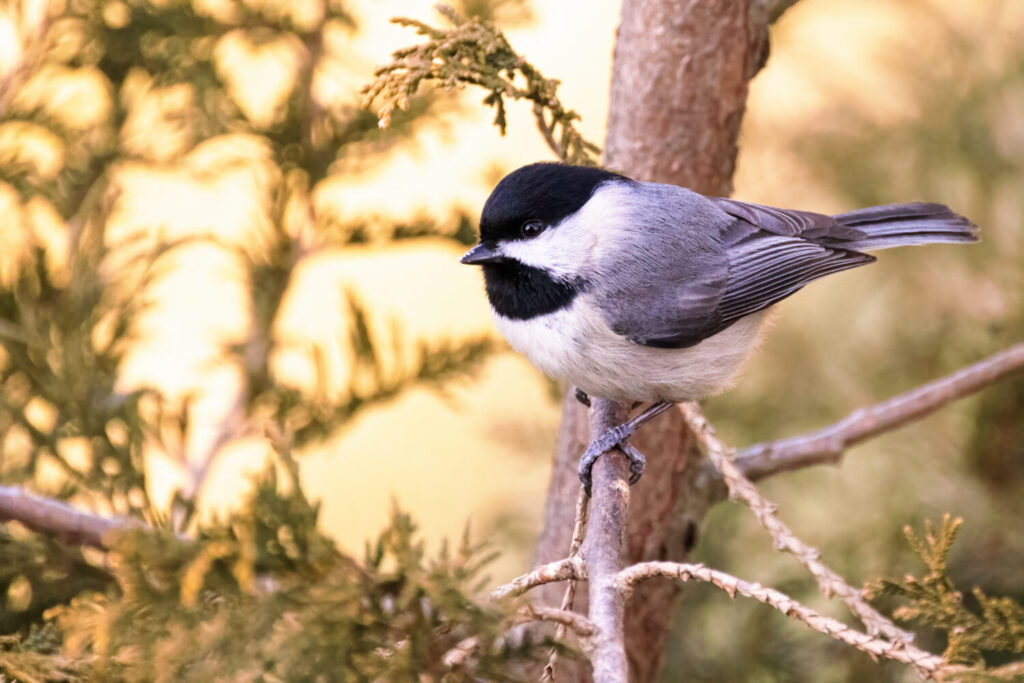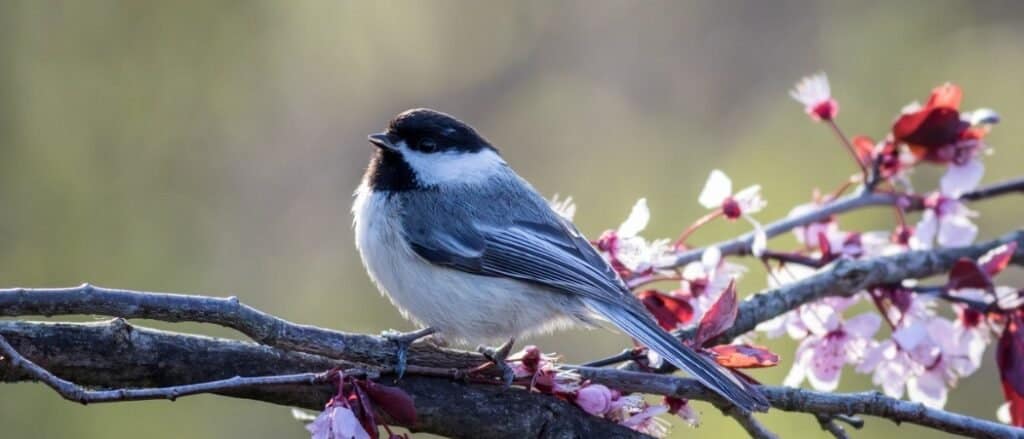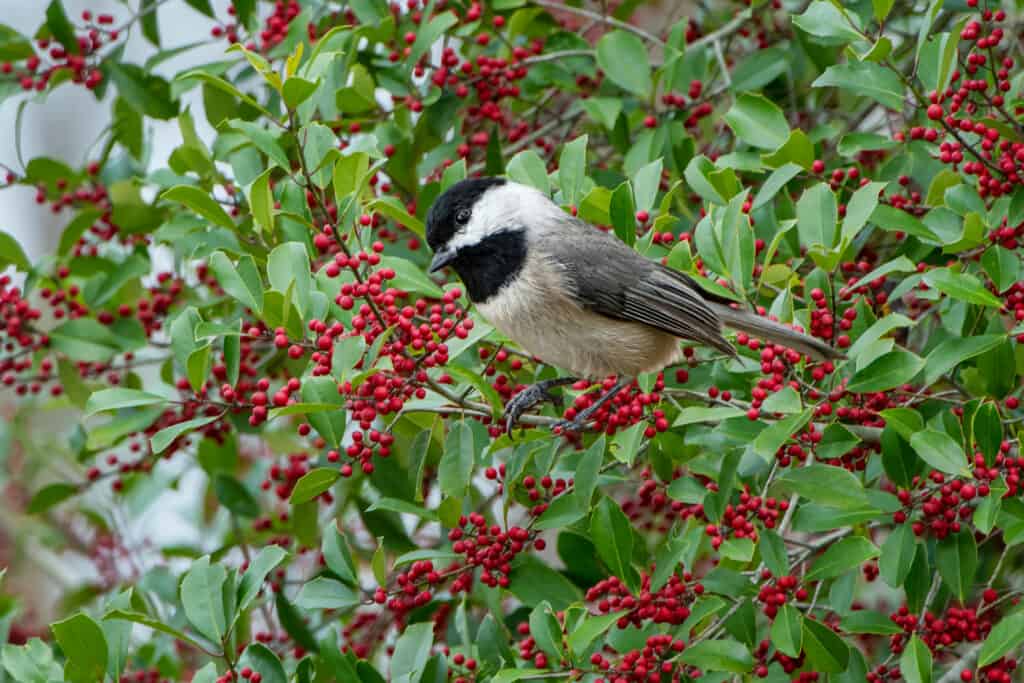When it comes to identifying two species with similar appearances, few birds make it as difficult as the black-capped chickadee and the Carolina chickadee. At first glance, these species are virtually identical, especially if you’re identifying them from afar while bird-watching. However, while they share many similarities, there are ways and things to look for to help tell each bird apart. Below, learn the differences between the black-capped chickadee vs. the Carolina chickadee.
Ready to learn more? Let’s dive in.
Black-Capped Chickadee vs. Carolina Chickadee: Comparison
| Black-Capped Chickadee | Carolina Chickadee | |
| Range | Northern United States and Canada | Southeastern United States |
| Songs and Voice | One- or two-syllabled | Four-syllabled |
| Wing Pattern | White feather edges | White-gray feather edges |
| Facial Markings | Solid white markings | White to gray transitional markings |
| Size | 4 to 6 inches long | 4.5 inches long |
Black-Capped Chickadee vs. Carolina Chickadee: Summary
The black-capped chickadee and the Carolina chickadee are two highly similar species. They can be recognized by their black and white markings as well as their small, compact shapes.
The black-capped chickadee is slightly larger than the Carolina chickadee, growing to be up to 6 inches in length in comparison to 4.6 inches. It also has a different coloration than the Carolina chickadee, with more white edging on the wing feathers and less gray on the face and nape.
You’ll also find that there tends to be little overlap of their habitats. Black-capped chickadees are far more prevalent in the north, with Carolina chickadees in the south. In the few areas where both species can be found, however, you can identify them by their call. The call of the black-capped chickadee is shorter, usually comprising only one to two syllables compared to four.

Black-capped chickadees live farther north than the Carolina chickadee.
©Steve Byland/Shutterstock.com
Range
Neither of these two species migrate. Instead, they are year-round residents in their respective habitats.
The black-capped chickadee is found in the northern regions of North America. They can be found as far south as northern New Mexico and the Appalachian region of North Carolina and as far north as Alaska. Their range extends from coast to coast at its widest point.
The Carolina chickadee has a much smaller ranger. They range from central Florida north into Ohio. They can be found on the eastern coast as far west as central Texas.
There is a small overlap of these two species. This occurs around North Carolina and Virginia, as well as a select few other surrounding states. When their habitats merge, hybridization may occur between the black-capped chickadee and the Carolina chickadee.

The Carolina chickadee has a smaller ranger than the black-capped chickadee.
©Ami Parikh/Shutterstock.com
Songs and Voice
The voice of the black-capped chickadee is softer, often described with a sweeter tone. Usually, their calls consist of two to three whistles. In contrast, the Carolina chickadee is able to incorporate a variety of sounds in its songs, usually those more raspy than its northern counterpart. However, the sounds are still high-pitched. When they whistle their signature tune, it tends to have four notes, more than that of the black-capped chickadee.
Wing Pattern
In terms of coloration, the black-capped chickadee and the Carolina chickadee vary most in appearance on their wings. The black-capped chickadee sports striking white edgings on the feathers. These markings are less noticeable on the Carolina chickadee due to both their smaller size and the gray versus white coloration. In some individuals, the gray can be so subtle that it may not appear visible at first glance.

The black-capped chickadee has notable white markings on its wings.
©Rabbitti/Shutterstock.com
Facial Markings
The differences in facial markings between the black-capped chickadee vs. the Carolina chickadee can be difficult to see. This is because they are exceptionally subtle. Both species share the same black caps and black bibs. They also have the same stark white cheeks.
One of the only differences in their facial markings can be found at the nape of the neck. For the Black-capped chickadee, the stark coloration of their cheek makes up the entirety of their heads. However, for the Carolina chickadee, the white develops a grayish tone towards the nape.
Overall Plumage Color
The Carolina chickadee is overall duller in coloration than the black-capped chickadee. They sport mostly white and black markings with soft gray accents. While this is the same for the black-capped chickadees, there are some lighter hues that might be present in their plumage. Occasionally, their coloration will include olive hues in the buff coloring of their sides.
Size
At first glance, the black-capped chickadee and Carolina chickadee may appear equal in size. Both species are small and compact. However, the black-capped chickadee is larger than its southern counterpart.
The black-capped chickadee grows to lengths up to 6 inches long. They weigh between 0.3 to 0.5 ounces. Their wingspan is 6.3 to 8.3 inches. The Carolina chickadee instead has a length of 4.7 inches with a weight between 0.3 to 0.4 ounces. Their wingspan ranges from 5.9 to 7.9 inches.

The Carolina chickadee is smaller than the black-capped chickadee.
©Bonnie Taylor Barry/Shutterstock.com
The photo featured at the top of this post is © iStock.com/lgunderson
Thank you for reading! Have some feedback for us? Contact the AZ Animals editorial team.







